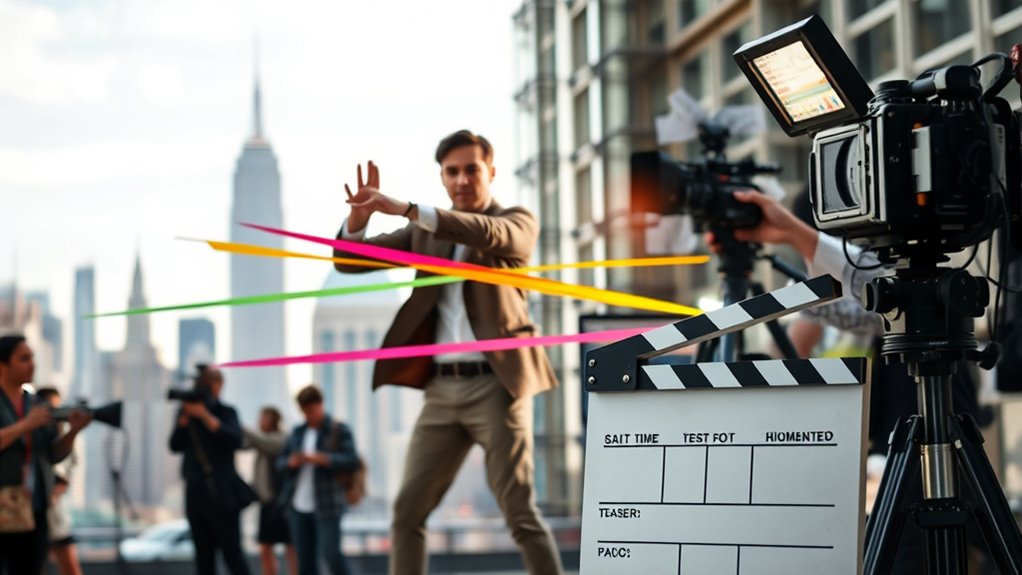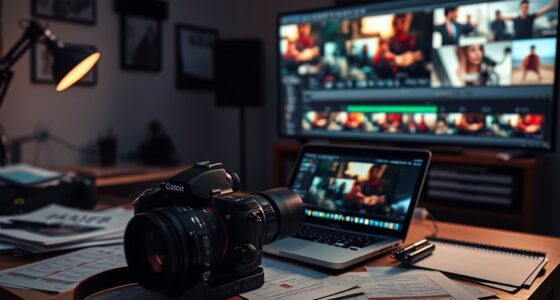To block actors for dynamic teaser shots, start by planning actor positioning carefully to create visual interest and emotional impact. Use camera angles like low or high shots to emphasize power or vulnerability, and incorporate movement to add energy. Think about how actor placement interacts with camera choices—diagonals, asymmetry, and depth make scenes more engaging. Mastering these techniques results in teaser shots that captivate viewers and set the tone; continue to explore for more effective strategies.
Key Takeaways
- Use intentional actor positioning with diagonals and asymmetry to add visual interest and energy.
- Incorporate varied camera angles—low, high, over-the-shoulder—to emphasize mood and create dynamic shots.
- Move actors during rehearsals to discover natural, energetic placements that enhance emotional impact.
- Coordinate blocking with camera work to ensure shots feel purposeful and highlight key story beats.
- Balance actor movement and positioning to build tension, relationships, and a sense of progression on screen.

When preparing for dynamic teaser shots, blocking actors effectively is essential to capturing the energy and emotion you want on screen. Your goal is to craft a scene that feels alive, engaging, and visually interesting. To do this, you need to pay close attention to camera angles and actor positioning. These elements work together to guide the audience’s focus, highlight the story’s emotional beats, and create a sense of movement that keeps viewers hooked. Start by visualizing the shot in your mind. Think about the mood you want to evoke—whether it’s tension, excitement, or intimacy—and then plan your actor placement accordingly. The way actors are positioned on set influences not just how they look but how their performances are perceived. It’s essential to place them in a way that complements the camera angles you plan to use, ensuring each shot feels purposeful and dynamic.
Effective blocking and camera angles create dynamic, emotionally resonant teaser shots that captivate viewers.
Camera angles play a significant role in shaping the energy of your teaser. Low angles can make a character look powerful or intimidating, while high angles might suggest vulnerability or submission. Over-the-shoulder shots create intimacy, drawing viewers into the characters’ conversations, whereas wide shots establish the environment and spatial relationships. When blocking actors, consider how these angles will interact with their positioning. For instance, positioning an actor slightly off-center can make the shot more visually compelling and leave room for camera movement. Conversely, centering an actor can emphasize importance or focus. Adjust actor placement to maximize these effects, ensuring each camera angle enhances the scene’s emotional impact.
Actor positioning isn’t just about where someone stands; it’s about how their placement conveys relationships, tension, and story beats. Moving actors around during rehearsal helps you find the most dynamic positions, especially for teaser shots that thrive on energy and unpredictability. Use diagonals, asymmetry, and depth to add visual interest. Keep in mind that the way actors move within the frame will influence how camera angles are chosen and how shots are composed. For example, a character moving from left to right across the frame can create a sense of progression or transition when paired with a specific camera angle. This choreography of positions and angles is what gives your teaser shots their vibrancy and appeal. Additionally, understanding the importance of blocking actors and their relationship with camera work can greatly enhance the storytelling and visual dynamism of your scenes. Proper blocking also helps ensure safety and comfort for your actors, which can improve their performances and the overall production quality. Developing a clear blocking plan early on can streamline your shooting schedule and reduce the need for costly reshoots or adjustments. As you refine your scene, considering visual composition and how actors interact within the frame can make your teaser shots more captivating and memorable. Ultimately, effective blocking isn’t just about convenience; it’s about storytelling. Well-planned actor positioning combined with thoughtful camera angles will help you craft teaser shots that feel fresh, energetic, and emotionally resonant. When you master this balance, you’ll be able to create scenes that captivate audiences and leave them eager for more.
Frequently Asked Questions
How Do Blocking Techniques Differ Between Live-Action and Animated Scenes?
When considering blocking techniques, you focus on how camera angles and rehearsal timing shape scene dynamics. In live-action, you coordinate actors’ movements with camera setups, adjusting timing to match shots. For animation, you plan precise movements beforehand, since actors don’t perform live. You adapt your blocking to suit each medium, ensuring camera angles highlight emotion and action, whether during rehearsals or post-animation adjustments.
What Are Common Mistakes to Avoid When Blocking Actors for Teasers?
When blocking actors for teasers, you should focus on actor positioning to create visual interest and highlight key moments. Avoid timing missteps that can disrupt pacing or make scenes feel awkward. Keep your movements intentional and synchronized with the shot’s rhythm. Don’t overlook the importance of clear blocking instructions, and always rehearse to spot issues early. This helps guarantee your teaser flows smoothly and effectively captures the audience’s attention.
How Does Blocking Influence Audience Perception of Characters?
Blocking is like painting a vivid picture; it shapes how the audience perceives your characters. When you position actors to highlight emotional cues, you boost audience engagement and convey their inner feelings effectively. Thoughtful blocking guides viewers’ attention, making characters more relatable or intriguing. It influences perception by emphasizing relationships and emotions, ensuring your teaser leaves a lasting impact and draws viewers into the story right from the start.
What Tools Assist Directors in Planning Actor Movements During Blocking?
To plan actor movements effectively, you can use storyboarding techniques and digital planning tools. These tools help you visualize scenes, block actors precisely, and experiment with movements before filming. By creating detailed storyboards, you guarantee clarity and consistency. Digital planning software allows you to adjust actor positions dynamically, making your blocking more efficient and creative. This combination streamlines the process, helping you achieve your desired visual storytelling.
How Can Blocking Be Adapted for Multi-Camera Teaser Shots?
You might think adapting blocking for multi-camera teaser shots is complicated, but it’s manageable with planning. Focus on camera angles and actor positioning to guarantee each shot captures the right moment. Use marked marks on the floor and clear communication with your crew. Rehearse with all cameras rolling, adjusting actor movements to maintain fluidity. This approach helps you achieve dynamic shots without missing key actions or reactions.
Conclusion
Remember, blocking actors is like planting seeds in a garden—you shape the space to grow your story’s heart. When you skillfully arrange your actors, you’re guiding the viewer’s eye—like a lighthouse guiding ships through fog. Each movement becomes a stroke on your canvas, creating a visual symphony. Trust your instincts, and let the space breathe life into your teaser, turning simple shots into powerful symbols of your story’s soul.









